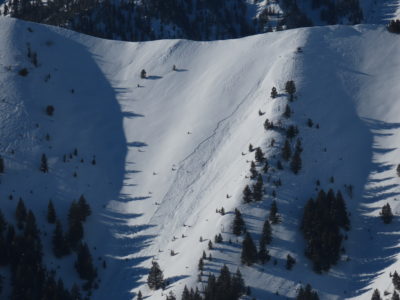Basic Information
Observation Details
Observation Date:
January 21, 2023Submitted:
January 22, 2023Observer:
SAC - VandenBos (off duty), O'ConnorZone or Region:
Galena Summit and Eastern MtnsLocation:
Trail Creek/Lake Creek Divide (6,100-10,400', most aspects)Signs of Unstable Snow
Recent Avalanches?
None ObservedCracking?
None ExperiencedCollapsing?
None ExperiencedSnow Stability
Stability Rating:
GoodConfidence in Rating:
ModerateStability Trend:
ImprovingBottom Line
We traveled through a lot of untraveled terrain without receiving any direct signs of instability other than the small avalanches we observed. However, the presence of multiple buried weak layers drove our travel decisions and kept us out of large, steep, complex avalanche terrain.
Advanced Information
Weather Summary
Cloud Cover:
Mostly SunnyWind:
Calm , WCalm to light westerly winds and generally clear all day long, with a few high stratus occasionally streaming by.
Avalanche Observations
| # | Date | Location | Size | Type | Bed Sfc | Depth | Trigger | Comments | Photo |
|---|---|---|---|---|---|---|---|---|---|
| 1 |
SE 8800 |

|
We observed debris from a number of large avalanches that likely happened in December. We also observed several very small wind slabs and slightly larger wind slab from the past few days. Based on character of the crown this slab was likely moving on some weak layer, best guess would be a crust with facets on top.
Snowpack Observations
Mostly moving observations. Wide variety of surface conditions to be found, including stiff wind board and icy crusts, but plenty of soft snow out there. Diurnal faceting was breaking down many crusts and thin hard slabs that had formed previously. Dug one pit in exposed terrain on a W/NW aspect at 9,000' looking for weak layer preservation in the upper snowpack. We found 1/5 and 1/8, buried 30 and 35 cm down. There were SH shards here that were laid over on their faces. These layers produced rough fractures (RP to BRK) in ECT. We also found a thin layer of 2-4mm standing SH down 4cm that is likely 1/18. I've found this surface preserved in several places in the WRV, it is something to keep eyes on when snowfall returns.
Terrain Use
We generally avoided avalanche terrain, but felt comfortable traveling through some terrain in the low 30s that lacked a significant slab on the surface. We looked at a lot of big, complex avalanche terrain that looked like it would provide excellent skiing that we opted not to ski.

